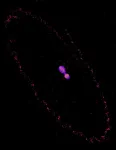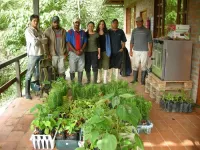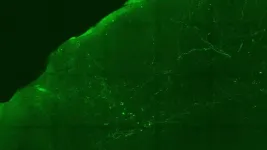(Press-News.org) Billions of years ago, in the frigid outer reaches of our solar system, two icy worlds collided. Rather than destroying each other in a cosmic catastrophe, they spun together like a celestial snowman, finally separating while remaining forever linked in orbit. This is how Pluto and its largest moon, Charon, originated, according to a new University of Arizona study that challenges decades of scientific assumptions.
A study led by Adeene Denton, a NASA postdoctoral fellow who conducted the research at the U of A Lunar and Planetary Laboratory, has revealed this unexpected "kiss and capture" mechanism, which could help scientists better understand how planetary bodies form and evolve. By considering something planetary scientists had overlooked over decades – the structural strength of cold, icy worlds – researchers have discovered an entirely new type of cosmic collision.
The findings were published in the journal Nature Geoscience.
For decades, scientists have theorized that Pluto's unusually large moon Charon formed through a process similar to Earth's moon – a massive collision followed by the stretching and deformation of fluid-like bodies, Denton said. This model worked well for the Earth-moon system, where the intense heat and larger masses involved meant the colliding bodies behaved more like fluids. However, when applied to the smaller, colder Pluto-Charon system, this approach overlooked a crucial factor: the structural integrity of rock and ice.
"Pluto and Charon are different – they're smaller, colder and made primarily of rock and ice. When we accounted for the actual strength of these materials, we discovered something completely unexpected," Denton said.
Using advanced impact simulations on the U of A's high-performance computing cluster, the research team found that instead of stretching like silly putty during the collision, Pluto and the proto-Charon actually became temporarily stuck together, rotating as a single snowman-shaped object before separating into the binary system we observe today. A binary system occurs when two celestial bodies orbit around a common center of mass, much like two figure skaters spinning while holding hands.
"Most planetary collision scenarios are classified as 'hit and run' or 'graze and merge.' What we've discovered is something entirely different – a 'kiss and capture' scenario where the bodies collide, stick together briefly and then separate while remaining gravitationally bound," said Denton.
"The compelling thing about this study, is that the model parameters that work to capture Charon, end up putting it in the right orbit. You get two things right for the price of one," said senior study author Erik Asphaug, a professor in the Lunar and Planetary Laboratory.
The study also suggests that both Pluto and Charon remained largely intact during their collision, with much of their original composition preserved. This challenges previous models that suggested extensive deformation and mixing during the impact, Denton said. Additionally, the collision process, including tidal friction as the bodies separated, deposited considerable internal heat into both bodies, which may provide a mechanism for Pluto to develop a subsurface ocean without requiring formation in the more radioactive very early solar system – a timing constraint that has troubled planetary scientists.
The research team is already planning follow-up studies to explore several key areas. The team wants to investigate how tidal forces influenced Pluto and Charon's early evolution when they were much closer together, analyze how this formation scenario aligns with Pluto's current geological features, and examine whether similar processes could explain the formation of other binary systems.
"We're particularly interested in understanding how this initial configuration affects Pluto's geological evolution," Denton said. "The heat from the impact and subsequent tidal forces could have played a crucial role in shaping the features we see on Pluto's surface today."
END
Newly discovered 'kiss and capture' mechanism explains the formation of Pluto and its largest moon
2025-01-06
ELSE PRESS RELEASES FROM THIS DATE:
New method tracks the 'learning curve' of AI to decode complex genomic data
2025-01-06
Introducing Annotatability—a powerful new framework to address a major challenge in biological research by examining how artificial neural networks learn to label genomic data. Genomic datasets often contain vast amounts of annotated samples, but many of these samples are annotated either incorrectly or ambiguously. Borrowing from recent advances in the fields of natural language processing and computer vision, the team used artificial neural networks (ANNs) in a non-conventional way: instead of merely using the ANNs to make predictions, the group inspected the difficulty with which they learned to label ...
Nutrient enrichment: an emerging threat to tropical forests
2025-01-06
Tropical forests, often referred to as the "lungs of the Earth," are essential for sustaining life on our planet. They provide clean air, water, and unparalleled biodiversity. While deforestation due to slash-and-burn agriculture, mining, and logging remains the most recognized threat, less visible but equally dangerous forces are at work. A new study reveals that nutrient enrichment – driven by human activities such as agriculture and fossil fuel combustion – poses a significant risk to the delicate dynamics of tropical forests.
The research, conducted by an international team of scientists ...
Scientists identify low-cost adsorbents for removing impurities from landfill gas
2025-01-06
Landfill gas, a mixture of gases produced when garbage breaks down within landfills, contains unwanted traces of siloxane compounds, which are chemical structures containing silicon and oxygen bonds and are found in various products like cosmetics and cleaning agents. These compounds can damage the equipment used to generate energy from landfill gas. In new research published in Environmental Progress & Sustainable Energy, investigators have identified low-cost adsorbents for siloxane removal from landfill gas.
The research highlights the potential of ...
CDC grant funds initiatives for breast cancer patients
2025-01-06
Weill Cornell Medicine has received a five-year, $2.3 million grant from the Centers for Disease Control and Prevention to improve equitable access to care, quality of life and survival outcomes for young people with all stages of breast cancer.
The grant will enable Weill Cornell Medicine to enhance care coordination for patients and caregivers to optimize support of physical, mental, emotional, social and spiritual needs, while offering culturally relevant resources and targeted interventions. The initiative ...
How can similar news stories influence financial markets? Here’s what investors need to know
2025-01-06
BINGHAMTON, N.Y. -- Have you ever noticed a swath of similar business news stories about a particular topic during a Google search, all of them appearing to be reported by different news outlets?
Why might a story on a news site in New York be so similar to one from a site in, for example, Wisconsin? It’s likely because the same media company owns them — and it’s become more commonplace nationwide as news outlets grapple with dwindling resources.
A new study co-authored by Flora Sun, assistant professor of accounting at Binghamton University’s School of Management, ...
Mixed signals: How the brain interprets social cues
2025-01-06
Imagine you’re at a dinner party, but you can’t smell the food cooking or hear the dinner bell. Sounds like a dream, right? What if it wasn’t?
“When we experience the world and interact with people, we use all our senses,” Cold Spring Harbor Laboratory Professor Stephen Shea says. “That’s true for animals and humans.” However, that’s not always the case in developmental disorders like autism. These conditions can affect how the brain processes incoming information, making it difficult to interpret the social cues that drive conversations, dates, and other ...
Climate extremes in 2024 ‘wreaking havoc’ on the global water cycle
2025-01-06
2024 was another year of record-breaking temperatures, driving the global water cycle to new climate extremes and contributing to ferocious floods and crippling droughts, a new report led by The Australian National University (ANU) shows.
The 2024 Global Water Monitor Report, involving an international team of researchers and led by ANU Professor Albert van Dijk, found rising temperatures are changing the way water moves around the planet, “wreaking havoc” on the water cycle.
“Rising ...
Acoustic sensors find frequent gunfire on school walking routes
2025-01-06
COLUMBUS, Ohio – A new study used acoustic sensors that detect the sound of gunfire to show how often children in one Chicago neighborhood are exposed to gunshots while walking to and from school.
Results showed that nearly two-thirds of schools in the Englewood neighborhood of Chicago had at least one gun incident within 400 meters (about one-quarter mile) of where children were walking home during the 2021-22 school year.
These findings suggest a need to redefine federal definitions of school gun violence to include indirect forms of violence that take place near schools, not only on school grounds, in order to more appropriately ...
New quantum sensing technology reveals sub-atomic signals
2025-01-06
Since the 1950s, scientists have used radio waves to uncover the molecular “fingerprints” of unknown materials, aiding in tasks as varied as scanning the human body with MRI machines and detecting explosives at airports.
These methods, however, rely on signals averaged from trillions of atoms, making it impossible to detect tiny variations between individual molecules. Such limitations hinder applications in fields like protein research, where small differences in shape control functionality and can determine the difference between health and disease.
Sub-Atomic Insights
Now, engineers at the University of Pennsylvania ...
Significant funding to ensure personalized treatments that work for rheumatoid arthritis
2025-01-06
In recent years treatment with powerful biologic and targeted synthetic therapies has changed the landscape for arthritis, but currently finding the right treatment for each person is a matter of trial and error. Only a proportion of patients with inflammatory arthritis respond to each expensive therapy, which results in unnecessary treatment and a long and often frustrating journey for patients, not to mention significant cost to the NHS.
University of Birmingham researchers have just been awarded £3.5 million funding from Johnson & Johnson to investigate ...




